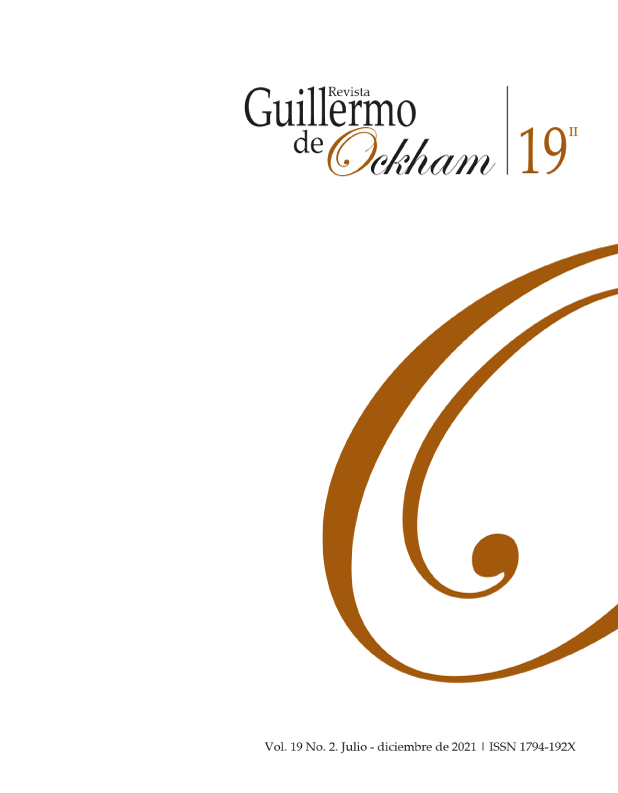The Revista Guillermo de Ockham provides an immediate and open access to its content, based on the principle of offering the public a free access to investigations to provide a global interchange of knowledge.
Unless otherwise established, the contents of this journal has a license with Creative Commons Attribution-NonCommercial-NoDerivatives 4.0 International (CC BY-NC-ND 4.0) http://creativecommons.org/licenses/by-nc-nd/4.0/
- Attribution: You must give appropriate credit, provide a link to the license, and indicate if changes were made. You may do so in any reasonable manner, but not in any way that suggests the licensor endorses you or your use.
- NonCommercial: You may not use the material for commercial purposes.
- NoDerivatives: If you remix, transform, or build upon the material, you may not distribute the modified material.
- No additional restrictions: You may not apply legal terms or technological measures that legally restrict others from doing anything the license permits.
Abstract
The ecumenical determination that joins the Christian churches together today warrants a revision of the projects that have been promoted along those lines through the centuries that followed the separation of the Western and Eastern churches. The Council of Basel-Ferrara-Florence-Rome, in the mid-15th century, is a milestone in this ecclesial itinerary. Encouraged by Rome and Constantinople, the surviving religious and political capitals of the Western and Eastern empires, which are now considered to be ecumenical by the former but not by the latter, make part of those attempts. Included as an achievement, albeit a short-term one, its effective influence on the union of the two ecclesial communities has been lost in the twists and turns of history. The aim of the article will be to unravel its current significance for the Christian ecumenical cause by means of an historical-hermeneutical approach that examines the intersecting political and religious interests.
Keywords:
References
Bethencourt, F. (2017). Razzismi. Dalle Crociate al XX secolo. Bologna: Il Mulino.
Caporilli, M. (1999). Los papas. Los concilios ecuménicos. Los jubileos - Años santos. Historia e imágenes. Euroedit, Trento: Euroedit, 6ª ed.
Castiglioni, C. (1936). Storia dei papi (II). Torino: UTET.
Corominas, J. (2000). Breve diccionario etimológico de la lengua castellana. Madrid: Gredos.
Delumeau, J. (1989). El miedo en Occidente (Siglos XIV-XVIII). Una ciudad sitiada. Madrid: Taurus.
Gallina, M. (2001). Ortodossia ed eterodossia. In Filoramo, G., Menozzi D. (a cura di). Storia del cristianesimo. Il Medioevo (pp. 107-218). Bari: Laterza.
Giametta, P. (2018). Breve storia dei Concili Ecumenici. Dal Concilio di Nicea al Concilio Vaticano II. Roma: Gedi.
Guignebet, Ch. (1988). El cristianismo medieval y moderno. Mexico: Fondo de Cultura Económica.
Harari, Y. (2020). 21 lezioni per il XXI secolo. Roma: Gedi.
Küng, H. (2008). Cristianesimo. Essenza e storia. Milano: BUR, 2ª ed.
Laboa, J. M. (2007). La storia dei papi. Tra il regno di Dio e le passioni terrene. Milano: Jaca Book.
Le Goff, J. (2008). Gli intellettuali nel Medioevo. Milano: Mondadori.
Le Goff, J. (2013). La civiltà dell´Occidente medievale. Milano: Mondadori.
Lorenzi, A. (2020). Chiesa e potere. L´arrettatrezza dell´Italia è colpa del Vaticano? Milano: Il Giornale.
Melloni, A. (1993). Los siete concilios “papales” medievales. En Alberigo, G. (Ed.). Historia de los concilios ecuménicos (pp. 157-184). Salamanca: Sígueme.
Merlo, G. G. (2001). Il cristianesimo latino bassomedievale. In Filoramo, G., Menozzi, D. (A cura di). Storia del cristianesimo. Il Medioevo (pp. 219-314). Bari: Laterza.
Mieli, Paolo (2015). L´arma della memoria contra la reinvenzione del passato. Milano: Mondadori.
Moliner, M. (1979). Diccionario de uso del español (H-Z). Madrid: Gredos.
Pricoco, S. (2001). Da Costantino a Gregorio Magno. In Filoramo, G., Menozzi, D. (A cura di). Storia del cristianesimo. L´antichità (pp. 273-416). Bari: Laterza.
Proch, U. (1993). La unión en el segundo Concilio de Lyon (1274) y en el Concilio de Ferrara-Florencia-Roma (1438-1445). En Alberigo, G. (Ed.). Historia de los Concilios ecuménicos (pp. 237-268). Salamanca: Sígueme.
Prodi, P. (1982). Il sovrano pontefice. Bologna: Il Mulino.
Rendina, C. (2011). I papi. Da san Pietro a papa Francesco. Storia e segreti. Roma: Newton Compton, 2ª ed.
Sandri, L. (2013). Dal Gerusalemme I al Vaticano III. I Concili nella storia tra Vangelo e potere. Trento: Il Margine.
Uribe Rueda, A. (1998). Bizancio, el dique iluminado. La concepción mística del universalismo, sus raíces judías y helénicas y su herencia cristiana. Bogotá: Herder.
Villari, R. (2000). Mille anni di storia. Dalla città medievale all´unità dell´ Europa. Roma-Bari: Laterza.
Wohlmuth, J. (1993). Los concilios de Constanza (1414-1418) y Basilea (1431-1449). En: Alberigo, G. (Ed.). Historia de los concilios ecuménicos. (pp. 185-236). Salamanca: Sígueme.

































